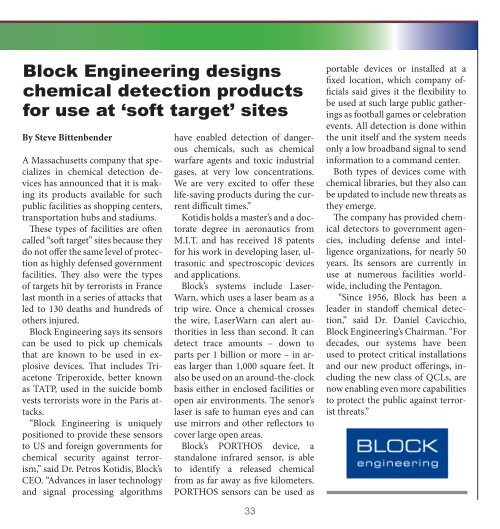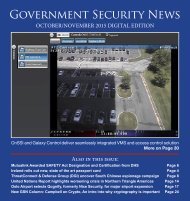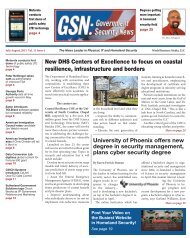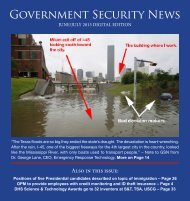GSN January 2016 Digital Edition
Create successful ePaper yourself
Turn your PDF publications into a flip-book with our unique Google optimized e-Paper software.
Block Engineering designs<br />
chemical detection products<br />
for use at ‘soft target’ sites<br />
By Steve Bittenbender<br />
A Massachusetts company that specializes<br />
in chemical detection devices<br />
has announced that it is making<br />
its products available for such<br />
public facilities as shopping centers,<br />
transportation hubs and stadiums.<br />
These types of facilities are often<br />
called “soft target” sites because they<br />
do not offer the same level of protection<br />
as highly defensed government<br />
facilities. They also were the types<br />
of targets hit by terrorists in France<br />
last month in a series of attacks that<br />
led to 130 deaths and hundreds of<br />
others injured.<br />
Block Engineering says its sensors<br />
can be used to pick up chemicals<br />
that are known to be used in explosive<br />
devices. That includes Triacetone<br />
Triperoxide, better known<br />
as TATP, used in the suicide bomb<br />
vests terrorists wore in the Paris attacks.<br />
“Block Engineering is uniquely<br />
positioned to provide these sensors<br />
to US and foreign governments for<br />
chemical security against terrorism,”<br />
said Dr. Petros Kotidis, Block’s<br />
CEO. “Advances in laser technology<br />
and signal processing algorithms<br />
have enabled detection of dangerous<br />
chemicals, such as chemical<br />
warfare agents and toxic industrial<br />
gases, at very low concentrations.<br />
We are very excited to offer these<br />
life-saving products during the current<br />
difficult times.”<br />
Kotidis holds a master’s and a doctorate<br />
degree in aeronautics from<br />
M.I.T. and has received 18 patents<br />
for his work in developing laser, ultrasonic<br />
and spectroscopic devices<br />
and applications.<br />
Block’s systems include Laser-<br />
Warn, which uses a laser beam as a<br />
trip wire. Once a chemical crosses<br />
the wire, LaserWarn can alert authorities<br />
in less than second. It can<br />
detect trace amounts – down to<br />
parts per 1 billion or more – in areas<br />
larger than 1,000 square feet. It<br />
also be used on an around-the-clock<br />
basis either in enclosed facilities or<br />
open air environments. The senor’s<br />
laser is safe to human eyes and can<br />
use mirrors and other reflectors to<br />
cover large open areas.<br />
Block’s PORTHOS device, a<br />
standalone infrared sensor, is able<br />
to identify a released chemical<br />
from as far away as five kilometers.<br />
PORTHOS sensors can be used as<br />
portable devices or installed at a<br />
fixed location, which company officials<br />
said gives it the flexibility to<br />
be used at such large public gatherings<br />
as football games or celebration<br />
events. All detection is done within<br />
the unit itself and the system needs<br />
only a low broadband signal to send<br />
information to a command center.<br />
Both types of devices come with<br />
chemical libraries, but they also can<br />
be updated to include new threats as<br />
they emerge.<br />
The company has provided chemical<br />
detectors to government agencies,<br />
including defense and intelligence<br />
organizations, for nearly 50<br />
years. Its sensors are currently in<br />
use at numerous facilities worldwide,<br />
including the Pentagon.<br />
“Since 1956, Block has been a<br />
leader in standoff chemical detection,”<br />
said Dr. Daniel Cavicchio,<br />
Block Engineering’s Chairman. “For<br />
decades, our systems have been<br />
used to protect critical installations<br />
and our new product offerings, including<br />
the new class of QCLs, are<br />
now enabling even more capabilities<br />
to protect the public against terrorist<br />
threats.”<br />
33
















